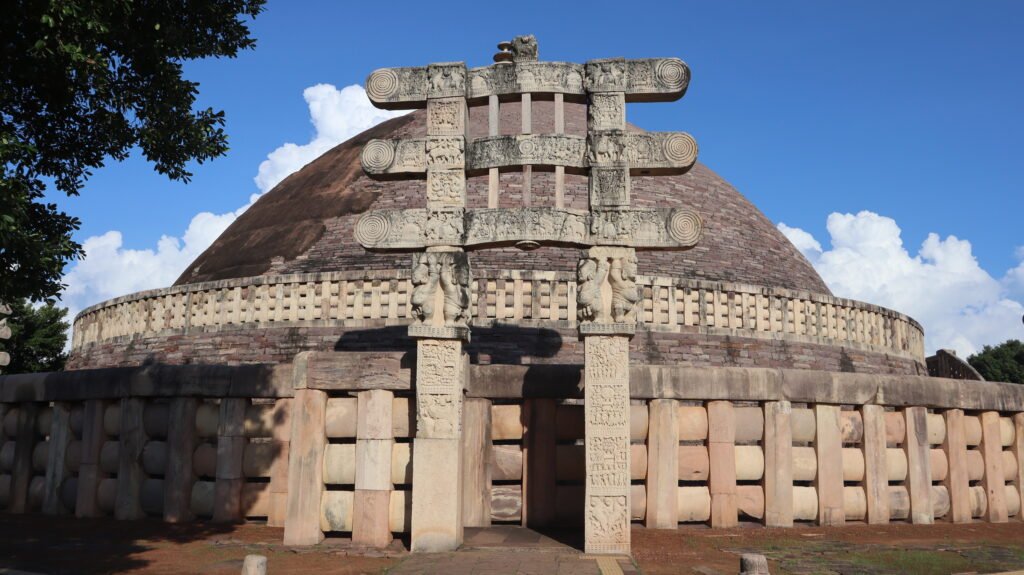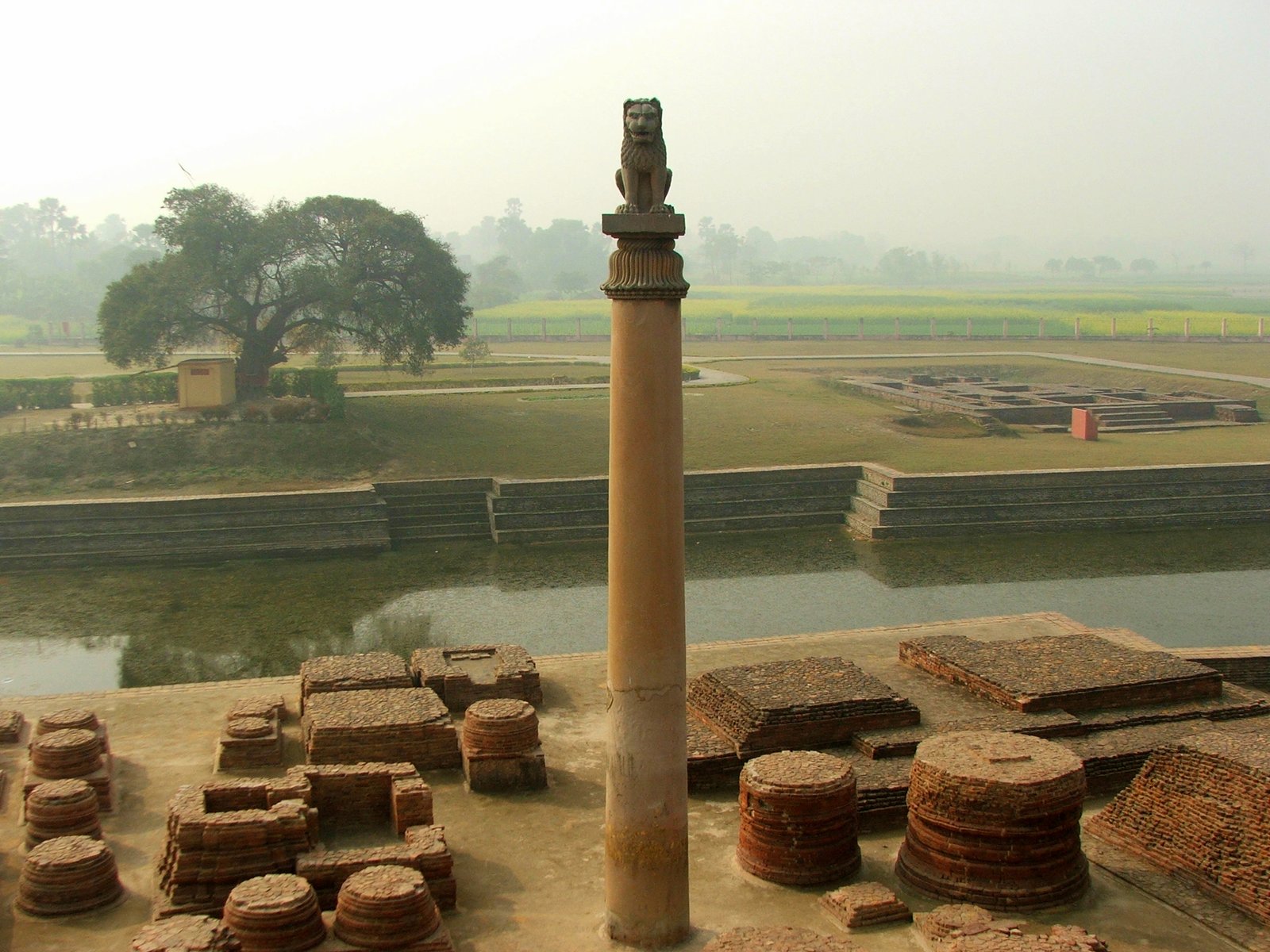The Mauryan Period saw great improvements in art, with the state producing outstanding works. This age introduced the use of durable materials, establishing stone as a popular medium for creative expression. This period saw the rise of Buddhist art and architecture, which had a significant cultural impact.
Foreign creative exchanges were prominent during the Mauryan period. The era’s rock-cut tradition features elaborate motifs and polished surfaces. Monumental design blossomed during this time, leaving a lasting creative impact.
Megasthenes identified the Royal Palace as a notable example of Mauryan art, which Fa Hein also mentions. Excavations at Kumrahar and Bulandibagh have confirmed the presence of the Royal Palace, with archaeologist Spooner making key contributions to the discovery.
Some historians argue that the Mauryan Pillars are exceptional examples of Mauryan art found throughout the empire. Chunar sandstone is used to build these pillars, which may reach heights of 40-50 feet and weigh around 50 tons each. These beautiful pillars have crucial components including the shaft, capital, inverted lotus, and crowned animal.
Mauryan pillars included crowning animals such as a lion at Lauria Nandangarth, four lions at Sarnath, a bull at Rampurva, and an elephant at Sankisha. The Mauryan period is remembered as a golden age of art.
Historians suggest that the Mauryan pillar is similar to the Persian or Achaemenid pillar, which existed before it.
| Mauryan pillar | Achaemenian pillar (Iranian/Persian) |
| Monolithic | Not monolithic |
| No base | Base |
| Tapering | width same |
| Animal capital | human |
| No part of any structure | part of the structure |
Although the Achaemenid pillars were more polished, Mauryan pillars differed from Persian pillars and cannot be considered exact duplicates. During this time, individuals in outlying regions interacted and influenced one another’s cultures.
Stupas in Mauryan Period
In Vedic literature, the term “stupa” refers to a piled-up construction or mound. The Mahaparinirvana Sutta highlights the importance of building stupas on Buddha’s cremated remains, making stupas a central concept in Buddhism. The Divyavadana states that Emperor Ashoka of the Mauryan realm built 84,000 stupas throughout the realm. Stupas, often composed of bricks and lacking extravagant embellishments, played an important role in the religious landscape.
Mauryan Stupas, built under the Mauryan Empire (322 BCE – 185 BCE) in ancient India, were large dome-shaped structures associated with Buddhism that served as important sacred places.
Purpose
The primary purpose of Mauryan Stupas was to house the relics of Lord Buddha and
other esteemed Buddhist monks. These structures held sacred significance and served
as pilgrimage destinations for followers of Buddhism.
Architecture
Mauryan Stupas were typically circular or oval in shape, with a hemispherical dome at the top. Stupas made of brick or stone were known for their elaborate carvings and sculptures.
Components
A typical Mauryan Stupa has three components: a circular base called the “anda,” a cylindrical drum called the “harmonica,” and a dome-shaped structure called the “chakra.” The harmonica was typically housed in a mast or pillar decorated with Buddhist iconography.
Location
These stupas were built in various parts of the Mauryan Empire, including present-day India, Nepal and Afghanistan. Notable examples are the Sanchi Stupa in Madhya Pradesh and the Piprahwa Stupa in Uttar Pradesh.
Significance
Mauryan Stupas were not only religiously significant, but also served as sites for spreading Buddhist teachings. They were instrumental in promoting and preserving Buddhism during the Mauryan era.
Ashoka’s Role
During the Mauryan period (r. 268 – 232 BCE), Emperor Ashoka played a vital role in building and promoting stupas. Ashoka not only built stupas but also sent Buddhist missionaries to spread the teachings of Buddhism throughout different regions.
Mauryan Stupas are important architectural and religious monuments of ancient India, representing the prosperity of Buddhism during the Mauryan Empire. Buddhists continue to respect these temples, attracting pilgrims from throughout the world.
Post Mauryan Period stupas

Post-Mauryan stupas are Buddhist structures built after the collapse of the Mauryan Empire. These structures followed architectural traditions from the Mauryan period, but also included new characteristics.
The Great Stupa in Sanchi, Madhya Pradesh, India, is one of the most well-known post-Mauryan stupas. Originally commissioned by the Mauryan monarch Ashoka, it was expanded and embellished by later kings. The Great Stupa in Sanchi is an important Buddhist pilgrimage site and one of India’s oldest stone constructions.
The Bharhut Stupa in Madhya Pradesh, dating back to the 2nd century BCE, is a notable post-Mauryan structure. The railings are artistically carved and portray scenes from Buddha’s life.
Post-Mauryan stupas maintained the circular base and hemispherical dome structure of earlier Mauryan stupas. However, they frequently included other elements such as gateways, railings, and sculptural ornamentation.
Stupas served as religious and cultural centers, containing relics of Buddha and other holy personalities. Furthermore, they helped spread Buddhism throughout India and abroad.
Rock-cut tradition
Rock-cut caverns have been discovered in several sites, including Barabar caverns, Nagarjuna Hills, Lomas Rishi Caves, Karna Chaupar Caves, Sudama Caves, and Vishwa Jhopari Caves. These caverns are known for their perfectly polished interiors.
Rock-cut architecture involves carving temples, monasteries, and other structures into solid rock. This practice is widespread throughout India, especially in Maharashtra, Karnataka, and Tamil Nadu.
Rock-cut constructions were created by carving into cliffs, slopes, and caves, reducing extra rock to reveal desirable architectural shapes. This custom in India originated around the 2nd century BCE and lasted until the 8th century CE.
These rock-cut caves were used for religious and monastic reasons, including temples, monasteries, prayer halls, viharas, and other sacred areas. The caverns frequently had complex carvings, sculptures, and paintings expressing religious themes.
Rock-cut temples in India include the Ajanta and Ellora Caves in Maharashtra, Badami Caves in Karnataka, and Mahabalipuram (Mamallapuram) in Tamil Nadu. These locations highlight the architectural and artistic excellence of India’s rock-cut tradition.
The rock-cut tradition highlights the artistic skills of ancient Indian craftspeople while also shedding light on their religious, cultural, and social practices. It is a significant part of India’s cultural history, attracting tourists and scholars from around the world.
Sculpture in the Mauryan Period
- Animal
- Lion
- Bull
- Elephant
- Human Figure
- Figures of Yaksha
- Figures of Yakshini
During the Post-Mauryan period, there was more connection with different cultures, resulting in a stronger influence of non-Indian creative aspects.
Stupa architecture and the rock-cut tradition continued, resulting in numerous stupas and viharas.
Kanishka built residential constructions during this era, with smaller pillars compared to Ashokan pillars. Milind Panho describes a city with gates, residences, towers, streets, and markets, which also had temple-like constructions.
Early temples from this period can be found in Jhandial (Taxila), Nagari (Rajasthan), Besnagar (Madhya Pradesh), and Nagarjuna Konda (Andhra Pradesh).
The Post-Mauryan period is known for its chaitya and vihara constructions found in places like Bhaja, Karle, Kanheri, and Kondana in Maharashtra, as well as the Udayagiri cave in Odisha.
Pre & Mains : Buy History NCERT 11th class by R.S.Sharma for UPSC
History Optional : Buy A History of Ancient And Early Medieval India : From the Stone Age to the 12th Century By Upinder Singh
Inline Image Credit and License :- Wikimedia Commons license
Featured Image Credit and License :- World History license
